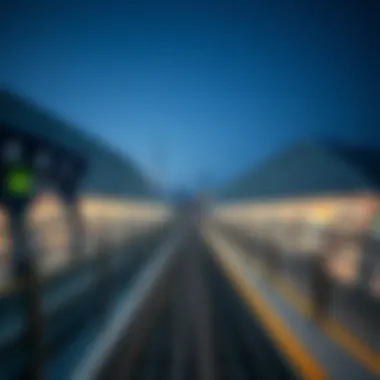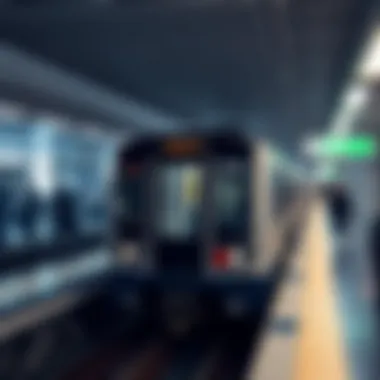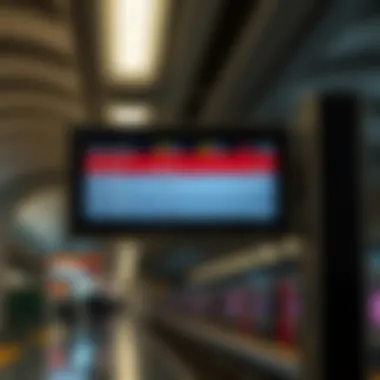Metro Operations in Dubai: Opening Hours and Schedule


Intro
Understanding the metro system in a city like Dubai is crucial for both locals and visitors. The Dubai Metro stands as one of the pillars of urban transport, not just aiding in the daily commutes of thousands but also shaping the city's growth and connectivity. Commuters often rely on this transit system to navigate through a city that's in constant flux, thanks to its bustling economy and expanding population.
With this article, we aim to dive into the operational hours of the Dubai Metro, shedding light on its standard schedules, weekend variations, and holiday adjustments. The significance of grasping these operational details cannot be overstated; they enable commuters to plan their travels efficiently, ensuring they are never caught off guard by unexpected service changes. Knowing when to hop on the train at the right time opens an avenue of convenience, particularly in a vibrant and fast-paced location like Dubai. This information will be particularly useful for investors and residents alike, who may find that the metro's accessibility impacts property values and lifestyle choices.
From understanding peak hours that might impede smooth transit to recognizing the seasonal adjustments that keep the system responsive to demand, we've got you covered. By the end of this comprehensive overview, we'll also take a look into how this knowledge serves as a practical guide for everyone who calls Dubai home or just came to explore its modern marvels.
Understanding the Dubai Metro
Understanding the Dubai Metro is essential for anyone navigating the vibrant city of Dubai. As a highly efficient public transportation system, it plays a pivotal role in shaping urban mobility, particularly in a rapidly growing metropolis known for its numerous attractions and diverse population. The metro is more than just a means of transport; it represents a significant infrastructural achievement that eases the daily hustle and bustle of both residents and visitors.
The convenience offered by the metro system cannot be overstated. Many commuters rely on it to connect with key neighborhoods, businesses, and entertainment hubs. The reliability of the metro's operations enhances the overall quality of life in the city, while also making it a competitive option for investors looking to understand urban transit dynamics. By grasping the operational hours and schedules of the metro, stakeholders can make informed decisions, whether it's for daily commuting or strategic business planning.
Historical Overview
The Dubai Metro was officially inaugurated in September 2009, marking a significant milestone in the emirate's commitment to developing sustainable urban transport systems. With an initial phase comprising 47 kilometers of track and 29 stations, it was designed to alleviate traffic congestion in the city, providing an alternative to the ever-increasing number of vehicles on the roads. The metro's development was rapid—just a few years after its launch, a second line was introduced, highlighting the city's vision for a modern and integrated transit system.
Historically, the metro was conceived as part of a larger distribution of transport options in Dubai, which includes buses, taxis, and water transport. This interconnectedness aims to provide seamless access across the emirate, making urban commuting more efficient. The metro has since continued to expand, integrating more areas into its network and catering to the city's growing population and influx of tourists.
Significance for Urban Transit
The Dubai Metro serves as a cornerstone of urban transit in the city, significantly contributing to both environmental sustainability and economic development. It facilitates the movement of hundreds of thousands of passengers every day, reducing traffic emissions and promoting a cleaner urban environment.
Moreover, from an economic perspective, the metro enhances accessibility to various commercial zones, thereby stimulating business growth. Areas like the Burj Khalifa and Dubai Mall benefit tremendously from the increased foot traffic generated by easy access to the metro system. Here are specific advantages it brings:
- Time Efficiency: By adhering to strict schedules, the metro significantly cuts down commuting times, allowing users to spend less time in traffic.
- Cost-Effective: Compared to other forms of transport, fares are reasonably priced, promoting use among various segments of society.
- Safety and Security: The metro system is equipped with state-of-the-art technology for passenger safety, which is paramount in urban settings.
- Scalability: As the city continues to grow, the modular nature of metro expansion ensures that future demands are met without significant upheaval to existing infrastructures.
As Dubai endeavors to position itself as a global hub for tourism and business, understanding the ramifications of the metro operations is vital for harnessing its full potential. With well-organized schedules and efficient routes, the Dubai Metro not only serves as a lifeline for daily commuters but also embodies the urban planning vision of the emirate.
Metro Opening Times
Understanding the operating hours of the Dubai Metro is crucial for anyone navigating this vibrant city, be it residents or tourists. The Dubai Metro not only serves as a backbone for urban transit but also facilitates smooth mobility across its key districts. Commuters rely heavily on punctuality, and knowing the metro’s schedule can make or break their daily routines. This segment explores the essential aspects surrounding metro opening times, shedding light on how these timings impact daily travel and contribute to the overall efficiency of urban transportation in Dubai.
Standard Hours of Operation
The standard operating hours for the Dubai Metro are strategically designed to accommodate its diverse user base. Typically, the weekdays see trains running from 5 AM to 12 AM, while during weekends, operations extend until 1 AM. This schedule allows for a generous window for commuting, catering to early risers and night owls alike.
- Early morning commuters can make use of the metro to reach their workplaces without a hitch.
- Late-night events or gatherings? The later hours help keep the city alive, making it easier to attend social functions and return home promptly.
"The metro functions as an urban lifeline, keeping the heart of the city pulsing with movement and accessibility."


Timing Variations on Weekends
When it comes to weekends, things shift a bit in Dubai. The metropolitan charm attracts both locals and tourists, so the metro adjusts its operating hours accordingly. On Fridays and Saturdays, the metro's schedule sees a slight extension, opening at 10 AM and continuing service until 1 AM. This variation helps accommodate weekend leisure activities, shopping sprees, and family outings.
Here’s a breakdown of the weekend timings:
- Fridays: 10 AM - 1 AM
- Saturdays: 5 AM - 1 AM
By extending operations on weekends, the Dubai Metro ensures it remains a convenient option, allowing visitors to explore attractions like the Dubai Mall and Burj Khalifa without worrying about transport.
Holiday Schedules
Public holidays in Dubai bring about specific changes in the metro’s operational hours. The Dubai Metro generally adjusts its schedule to offer longer service during significant holidays, aiming to provide an elevated level of access and convenience during peak times when the city buzzes with activity. For example, during Eid celebrations, the metro usually extends its service to accommodate the higher number of travelers.
Key points regarding holiday schedules include:
- Extended hours on public holidays, often from 5 AM to 2 AM
- Potential variations depending on the specific holiday, so it’s best to check the Dubai Roads and Transport Authority (RTA) website for accurate timings before planning any trips.
For anyone looking to make the most of their time in Dubai, being informed about the holiday schedules can be a game changer. Missing out on holiday festivities due to transport issues is not ideal, so staying updated is key.
In summary, understanding the metro opening times is paramount for both residents and visitors. The regular, weekend, and holiday timings play a critical role by enhancing urban transit efficiency, facilitating smooth movement around the city, and ultimately enriching the overall experience of commuters.
Factors Influencing Metro Hours
When it comes to the efficiency of any urban transit system, understanding the factors that shape operational hours is imperative. In Dubai, the metro not only serves as a vital transportation link for residents but also significantly impacts the mobility choices of tourists. The diverse demographics of commuters, including both local and expatriate populations, dictate variations that can be observed throughout the week and even during special occasions. Grasping these factors can lead to better transit decisions, ultimately easing the flow of life in this bustling emirate.
Peak Commuting Times
One of the most influential aspects affecting metro hours concerns peak commuting times. Typically, weekday rush hours see commuters flocking to and from workplaces, which generates a clamorous rush within the metro system. The need for extended hours during these times cannot be overstated. Morning peaks, usually between 7:00 AM to 9:00 AM, and evening peaks, from 5:00 PM to 8:00 PM, result in elevated demands on metro services. This presents a dual-edged sword; while it enhances accessibility for daily commuters, it also necessitates a keen understanding of rider volume.
Factors such as school hours and the schedules of local businesses considerably influence these peak periods. For families, school drop-offs align with morning commuting times, while late-night shopping in malls prompts extended metro hours during weekends. Thus, planning efficient timetable adjustments around these crucial periods means a better overall user experience for commuters.
Understanding peak times allows for a more tailored service, ensuring that the metro can handle surges in demand while optimizing the flow of those using it.
Special Events and Schedules
In the dynamic landscape of Dubai, special events—ranging from cultural festivals to international exhibitions—play a critical role in shaping metro operations. The Dubai Shopping Festival, for example, swells visitor numbers dramatically. The metro usually extends its operation hours during such events to accommodate the influx, offering convenience to both locals and tourists looking to enjoy the attractions the city has to offer.
Moreover, events hosted at venues such as the Dubai World Trade Centre often lead to temporary changes in the metro schedule. Nighttime concerts or trade exhibitions can see an increase in passengers which in turn warrants additional trips or extended hours. Notably, these adaptations help stimulate economic activity and offer improved accessibility to cultural experiences and business opportunities.
Flexibility in scheduling for such occasions provides a practical glimpse into how the metro system can evolve with the city’s rhythm—a quality that distinguishes it from many counterparts worldwide. As events draw nearer, checking updated schedules becomes a routine task for regular riders, reinforcing the metro's role as the lifeblood of urban mobility in the vibrant city.
Impact on Daily Commuters


The Dubai Metro system serves as a lifeline for daily commuters, providing them with an effective means of transportation across the bustling city. Understanding the impact this transit network has on residents and visitors alike is essential for grasping how urban mobility functions in a rapidly growing metropolis.
Access for Residents
Access to the metro is a game changer for Dubai's residents. Many neighborhoods are connected directly to metro stations, making it easier for locals to get to jobs, schools, and leisure activities. For instance, a resident living in Al Quoz can hop on the metro and reach their workplace in the business district without the usual hassle of traffic congestion. The affordability of the metro also cannot be overlooked; fares are comparatively lower than taxi rides or other private transport options. This pricing strategy encourages public transport use and helps reduce the overall carbon footprint of the city.
Moreover, with stations equipped with facilities for people with disabilities, the metro offers broad accessibility. Elevators and designated waiting areas ensure that everyone can rely on this service without unnecessary hurdles. The collaboration between the metro authority and local communities fosters a sense of inclusion, making the metro a viable option for all residents.
Visitor Accessibility
For visitors exploring Dubai, the metro presents an intuitive solution to navigate the diverse attractions the city offers. Tourists can easily purchase a NOL card, which facilitates smooth access to all metro lines and bus routes. This ease of use represents a major benefit for travelers unfamiliar with the city.
Cultural landmarks, amusement parks, and shopping centers are strategically situated near metro stations, simplifying travel plans. Whether it's visiting the stunning Burj Khalifa or enjoying family fun at Dubai Parks and Resorts, tourists have the flexibility to plan their itinerary without worrying about parking or navigation.
Additionally, clear signage and multilingual announcements help visitors feel at ease. They can follow along without facing language barriers, making for a more enjoyable travel experience.
Connection to Key Districts
The connectivity of the Dubai Metro to key districts lightens the load for daily commuters. Key areas like Downtown Dubai, Dubai Marina, and the Financial District are all conveniently linked by various metro lines. This integration reduces travel time significantly, making it feasible for professionals to hold jobs in bustling business areas while living in quieter neighborhoods.
- Downtown Dubai: Home to iconic landmarks, commuting here via metro is swift and hassle-free.
- Dubai Marina: Popular among expats and locals, residents can easily reach leisure and dining hotspots.
- Dubai International Financial Centre (DIFC): A hub for finance, professionals can jump on the metro and avoid the chaos of city cars.
In essence, the metro stands as an indispensable tool enhancing the quality of life for daily commuters. By providing seamless access to residential areas and key landmarks, the Dubai Metro is not just a transit option; it’s a crucial contributor to the city’s infrastructure and its residents’ well-being.
"Effective public transport systems not only enhance mobility but also strengthen community bonds, fueling local economies and improving overall living standards."
Regional Comparisons
Examining the operational framework of the Dubai Metro offers a window into the broader context of worldwide urban transit systems. Not only does this regional comparison shed light on the specific strengths and weaknesses of the Dubai Metro, it also helps stakeholders understand how various elements influence commuter experiences and choices in metropolitan environments. By evaluating different metro systems around the world, authorities and investors can discern valuable insights that might inform their strategies and decisions regarding improvements and expansions of Dubai’s own metro framework.
Metro Systems Worldwide
Several cities across the globe have invested heavily in their metro systems, each tailored to their unique cultural, geographic, and economic contexts. For instance, Tokyo's metro system is renowned for its punctuality and density, accommodating millions daily. It showcases an intricate network that serves not only urban areas but also surrounding prefectures effectively.
On the other hand, cities like New York present a different picture, where while the subway system is expansive, issues like aging infrastructure and delays are common. Comparatively, Dubai's metro stands out due to its modern infrastructure, automated systems, and relatively low operational costs. The Dubai Metro, with its sleek design and clean, efficient service, appeals to both residents and tourists alike, allowing it to become a central pillar of the city’s transport policy.
Another noteworthy example is the London Underground, characterized by its deep tunnels and iconic design. London's system benefits from a rich history but grapples with overcrowding and maintenance issues. These contrasts help highlight the successes Dubai has achieved, particularly with the ease of navigation and user-friendly systems, essentially a breath of fresh air for urban commuters compared to counterparts in other major cities.
Lessons from Other Major Cities
Diving deeper into how they operate, it becomes clear that there are learnings to be had. For example, cities like Singapore have mastered integrating technology in their transit, implementing contactless payments and real-time tracking. The operational flexibility of these systems, reflecting both efficiency and riders' needs, is something Dubai continues to strive for.


Implementing features like seamless transfers and improved signage could elevate commuters' experiences. Likewise, looking at cities that prioritize sustainability can help Dubai shape its future routes—balancing between development and environmental considerations is crucial.
In essence, evaluating how different metro systems handle similar challenges can provide critical insights that would benefit Dubai Metro operations, ensuring it remains a top choice for urban mobility. This comparative lens augments the discussion on operational hours, showcasing how they align with real-world practices and expectations with regard to commuter satisfaction and system reliability.
"By learning from the experiences of others, Dubai Metro can enhance its services, ensuring it meets the evolving demands of its users effectively."
User Experience and Feedback
User experience in the Dubai Metro system is a critical aspect to consider, reflecting the daily lives of countless commuters as well as visitors. Understanding how users interact with the metro not only sheds light on current operations but also highlights areas ripe for enhancement. The feedback received from commuters can result in informed decision-making that enhances service delivery and operational efficiency. This section explores two vital subcategories of user experience: commuter satisfaction and potential improvements.
Commuter Satisfaction
Commuter satisfaction is a reflection of how well the Dubai Metro meets the expectations and needs of its riders. The feedback often revolves around various elements such as timeliness, cleanliness, safety, and customer service. According to user surveys, many commuters appreciate the punctuality of the trains. A reliable schedule encourages a sense of trust and familiarity, which fosters repeated usage.
When observing the feedback, cleanliness comes up frequently. Passengers often express that a clean environment makes their journey pleasant. Regular maintenance and teamwork from the cleaning staff contribute to a welcoming atmosphere. Furthermore, safety remains paramount. Riders feel more satisfied when they see vigilant staff and efficient security measures in place. In a bustling city like Dubai, where diverse communities converge, ensuring safety is not just a priority; it's a necessity.
Finally, customer service can't be overlooked. Many users report positive interactions with station staff, underscoring how friendly service can impact their commuting experience. This interaction plays a pivotal role in how commuters perceive the overall quality of the metro. Feedback channels, like social media and official websites, showcase how important it is for the metro authorities to listen and adapt to user demands.
Potential Improvements
Despite the largely favorable feedback, areas for potential improvements certainly exist. Addressing these can play a vital role in refining the overall user experience.
- Real-Time Updates: Commuters often voice the need for real-time train tracking apps. While the current system offers schedules, integrating live updates on delays or changes can significantly enhance user satisfaction.
- Extended Service Hours: Weekend schedules are typically a hot topic among riders. Some express a desire for extended hours, particularly on weekends and holidays, allowing for greater flexibility in their travel plans.
- Accessibility Features: Feedback suggests that while the metro has made strides in accommodating passengers with disabilities, further enhancements—such as ramps and signage—could elevate accessibility.
- Upgraded Facilities: Improving station facilities, such as offering more seating and charging stations, can address comfort concerns during peak hours. Investments in better facilities would not only benefit commuters but also enhance the metro's reputation as a forward-thinking urban transit system.
- Enhanced Communication: Providing clearer information on services and potential changes can prevent confusion. Regular updates via social media or through the official website can keep users informed of any transitions, fostering trust and transparency.
"The best feedback is often found in the thoughts of the users themselves—they are the best metric for service quality."
Future Developments
The exploration of future developments in the Dubai Metro system carries significant weight for various stakeholders including investors, residents, and urban planners. As the population of Dubai continues to expand, the demand for efficient public transport becomes even more critical. Future developments promise not just an increase in the metro's reach but also its capacity to accommodate a diverse range of commuters. It's vital to consider how these advancements align with the overarching vision of sustainable urban growth.
Expansion Plans
The expansion plans for the Dubai Metro reflect an ambitious commitment to enhancing its service network. Authorities are laying the groundwork to develop new lines that cater to emerging districts and underserved areas.
- New Lines and Extensions: Plans are in motion to lay tracks connecting key points in the city, making it possible for more residents and tourists to utilize the metro service. For example, extending the Red Line further toward the Dubai AIrport will facilitate better access for travelers.
- Increased Capacity: Along with geographical expansion, there are strategies focused on increasing the capacity of existing trains. This means potentially reducing wait times during peak hours, catering more effectively to the high-volume traffic characteristic of the city.
- Consultation with Communities: Engaging local communities in the planning phase is essential. Residents often have insights into logistical hurdles that might not be evident to planners.
These expansion efforts are expected to bolster commuter satisfaction considerably. As more options arise, the accessibility of the system will vastly improve, consequently leveraging its significance in urban mobility.
Technological Advancements
Complementing physical growth, technological advancements within the Dubai Metro system hold the key to a seamless commuter experience. The shift toward smart transportation systems has been gaining impressive traction.
- Automated Systems: Innovations include the integration of automated ticketing solutions that avoid queues, making it convenient for passengers. This could range from mobile apps to facial recognition ticket systems that speed up the entry process.
- Real-Time Data: The implementation of real-time data tracking offers valuable insights into train schedules, allowing commuters to plan their travel better. This can be done through mobile alerts or station displays, reducing uncertainty.
- Sustainable Energy Initiatives: The metro system is also exploring sustainable energy sources to power operations. This not only aligns with global shifts towards green energy but is expected to lower operational costs in the long term.
Embracing technological advancements ensures that the metro service in Dubai remains ahead of the curve, promising an ongoing commitment to enriching the urban transport landscape.
Innovations in metro systems can dramatically enhance commuter experience and reduce the carbon footprint of urban transit.
The combination of expansion plans and technological advancements signifies a promising future for the Dubai Metro. For investors and stakeholders, understanding these developments is crucial in making informed decisions that align with Dubai's vision of a smart city. For residents and commuters, it means a more accessible, efficient, and comfortable public transport system.















